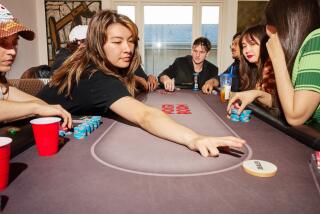How risky is risking it all?
In the course of putting opponents on a range of hands by factoring in styles and betting patterns, you attempt to conclude whether you have the best hand.
The top pros also try to determine whether they are a big enough favorite to make it worth risking all their chips.
In today’s hand from the 2009 World Series of Poker $10,000-buy-in main event at the Rio in Las Vegas, with blinds at $250-$500 plus a $50 ante, the woman in the hijack seat raised to $1,500 and got called by the player immediately to her left.
Greg Raymer, the 2005 WSOP main event champ, found A-Q offsuit in the small blind. Raymer called, as did the big blind, actor Jason Alexander.
Four players took a flop of Q-5-Q with two hearts, giving Raymer trips. Alexander bet $2,500. The other two players folded.
“I didn’t think there was any chance Jason would bet there with a flush draw,” Raymer said. “I thought he would check and fold. So I put him on a queen or pocket 5s, or maybe a pocket pair like jacks or 10s where he wanted to see a flop.”
Raymer called. The turn came the 10 of clubs. Raymer checked. Alexander bet $6,000. Raymer called.
The river came the 4 of diamonds. Raymer checked again. Alexander made it $12,000. Raymer called. Alexander showed Q-3 offsuit, getting outkicked by Raymer’s ace.
So Raymer took the pot -- with regret.
“I underplayed the hand,” Raymer said. “I should’ve played the hand faster. If I check-raise the turn or the river, I might’ve gotten all the chips in. I should’ve been willing to take that risk.
“I should’ve given him a broader range. If I had, I would’ve been a bigger favorite over that whole range and now I’m willing to risk all my chips in that spot.”
Table talk
Trips: Three of a kind where one hole card matches two on the board.
More to Read
Go beyond the scoreboard
Get the latest on L.A.'s teams in the daily Sports Report newsletter.
You may occasionally receive promotional content from the Los Angeles Times.









